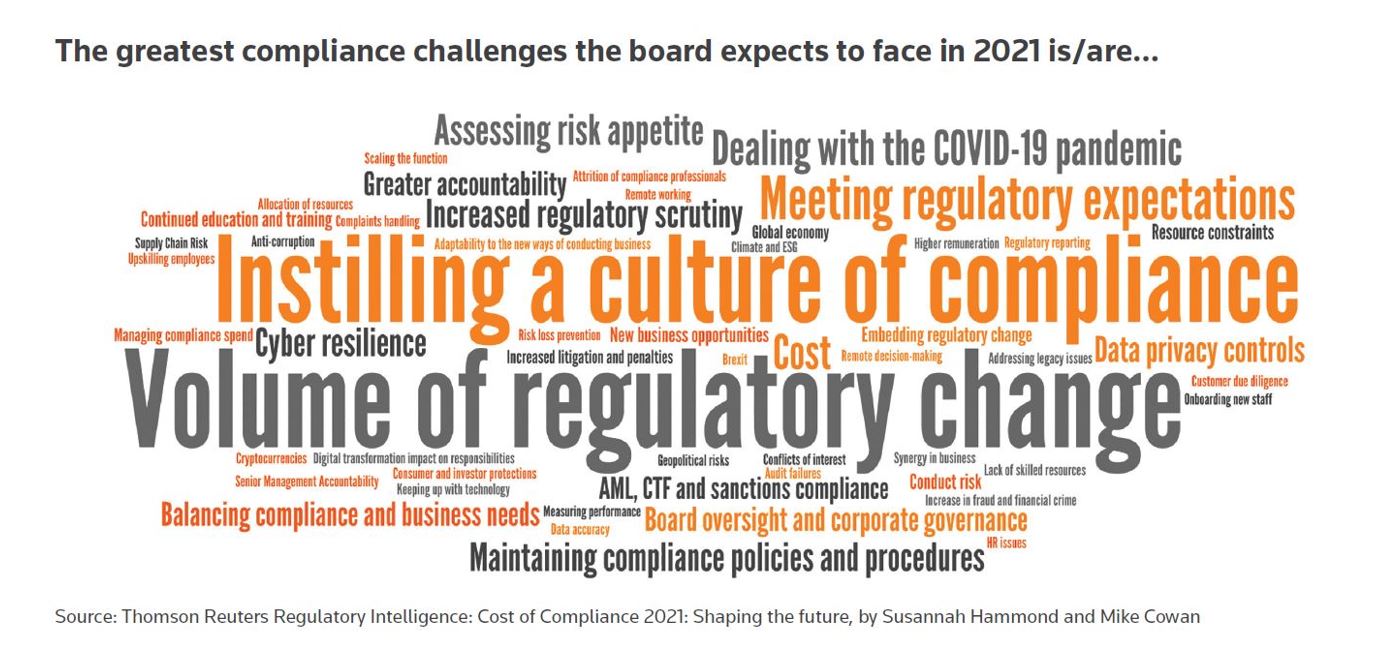The newly released 12th annual survey, "Cost of Compliance 2021", focuses on the challenges that the compliance functions at financial services firms may see in the next year
The impact of the global pandemic has changed ways of working, probably permanently. These changes have extended to the compliance function itself with new governance structures being adopted to ensure that the flow of management information remains tailored to the evolving needs of the business in order to better facilitate awareness of the risks, and in particular, those at the most senior levels within the firm.
Delving deeper into this, Thomson Reuters Regulatory Intelligence (TRRI) has released its 12th annual survey, Cost of Compliance 2021, focusing on the challenges the compliance functions at financial services firms around the world expect to face in the year ahead.
You can download a copy of the Cost of Compliance 2021 report here.
The 2021 survey generated responses from more than 720 practitioners worldwide, representing global systemically important financial institutions, banks, insurers, asset and wealth managers, broker-dealers, and payment services providers.
“Adaptability refers to the willingness to innovate and the pace of internal change…”
— Bank of England Staff Working Paper No.912 Organisational culture and bank risk. Suss et al. (March 2021)
The report highlights the need for change to support the wider cultural, operational (including technological), and staffing requirements. However, common to all these areas is the need for future investment and resources. Indeed, limitations on finances are inherently a barrier to successful change, and in the aftermath of the pandemic firms will be looking at ways to reduce cost and maximize revenue. This year, corporate boards thought that cost and dealing with the pandemic were their main challenges.
Now, compliance officers seem to be taking a more pragmatic view. The expectation in recent years has largely kept budgets the same; and this year reinforces that trend with 36% of respondents predicting budgets will remain the same (an increase over last year) and only 42% predicting a slight increase (down, compared to last year) with those predicting a significant increase in their budget down to 10%.
“Corporate culture comes from the top, and there is a strong need to incentivize companies to foster a culture of compliance — not misconduct. If companies believe they can profit from violations and are unlikely to be caught, they are more likely to break the rules.”
— Caroline A. Crenshaw, Commissioner at the U.S Securities and Exchange Commission (March 2021)
The top compliance challenges that boards and compliance officers said they are expecting to face was an increasing volume of regulatory change, particularly with a new administration in the U.S. and in the aftermath of Brexit. Also, the amount of regulatory information expected to be published by regulators and exchanges was expected to increase, with 78% of survey respondents saying they expected an increase in 2021.
“While we do not expect all banks to monitor each and every misconduct incident in all jurisdictions, we encourage banks to keep track of key international developments and draw lessons from major overseas misconduct incidents as far as possible.”
— Alan Au, Executive Director of Hong Kong Monetary Authority (November 2020)
Half of survey respondents said they expect the personal liability of compliance professionals to increase over the next 12 months, and 10% of those said they expect personal liability to increase significantly. Perhaps in light of these findings, 62% of respondents reported that the cost of time and resources devoted to conduct risk issues is expected an increase in 2021. Further, one-third of respondents reported turning down a potentially profitable business opportunity for conduct risk reasons.
The report makes clear that compliance officers need to shape their own future. Along with its raft of problems, the pandemic also has presented the financial services industry and compliance officers with an opportunity.
Regulators are seen to have had a good crisis, meaning that ideally firms should be able to say the same. Regulators have already committed to post-pandemic reviews; and firms may well consider that now is the time to engage with regulators about any change strategies they are contemplating. Firms should also be ready to flag key issues around technological initiatives and other innovations with regulators and be able to capitalize on early feedback and direction.
In summary, change is due. The social and economic environment provides firms and compliance officers with an opportunity to shape future changes. Planning and preparing a future direction that addresses all challenges is vital, and compliance officers need to be ahead of the game in their thinking.
You can also learn more about key findings in the report in several ways:
-
Join co-authors Susannah Hammond and Michael Cowan on June 9 for a fireside chat covering key insights from our global Cost of Compliance 2021 survey report. Moderated by Todd Ehret, this webinar gives you the chance to hear from the experts about how risk and compliance can drive and shape the future for financial services. You can register for this webinar.
-
You can also watch a video interview with Cost of Compliance 2021 report co-author, Susannah Hammond, Senior Regulatory Intelligence Expert for Thomson Reuters Regulatory Intelligence, here.
-
Or listen to Compliance Clarified, a regular podcast from Thomson Reuters Regulatory Intelligence.







